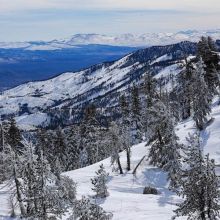It seems like we were just soaking in the sunshine by the lakeshore, but with the recent rain and snow in the higher altitudes, we’ve jumped right into the beginning of what feels like winter.
Winter in the Tahoe-Truckee region is exhilarating. You feel like you’re in a snow globe once you set foot amongst the towering snow-covered pines and peaks surrounding the cobalt blue lake. With the snowfall comes a plethora of adventure opportunities, including skiing, snowboarding, sledding and skating. And, the holidays invite you to slow down and spend time with loved ones.
But winter also brings a variety of hazards and unpredictable situations. Unexpected sudden shifts in the weather, road hazards, traffic delays and power outages can significantly impact your trip.
Below, I have compiled a list of tips to help you prepare for your winter stay in the region and make it safe and stress-free. I hope it helps and that you have the best time!

Photo: Weather and road conditions can change quickly. Staying informed and prepared will help you be safe and enjoy your time here.
Weather in the mountains can change quickly and unexpectedly. Light flurries can shift into a full winter storm within hours, creating white-out visibility and dangerous driving conditions. Before you head out, it’s imperative that you check the current road conditions and daily weather forecast to know what to expect, but also be prepared should the unexpected occur.
There are a variety of online resources for current reports on conditions, including chain control, hazards, highway and road closures, and weather alerts:
Caltrans QuickMap
Caltrans Road Information
Tahoe Roads
I always advise leaving for your destination early, as long as it looks clear. This way, you can give yourself time should anything change. Be prepared for anything and everything, even if the forecast looks ideal. Map out the route and any alternate routes along the way. Highlight gas stations and services along the way.
Make sure you have everything you need for your trip and for any unexpected challenges. I always advise creating an emergency kit for your car and your home (or rental), which would include water, food, blankets, layers, a flashlight, blanket, medications and first aid supplies, which I will outline in more detail below.
Emergency kits are an absolute necessity for your car and home should unexpected scenarios occur, including road closures and power outages. Besides keeping essentials such as food, water and clothing together for emergencies, it will also give you peace of mind knowing that you are prepared to tackle challenges ahead. Make sure you know where it is, how to use everything and that items with expiration dates are replaced when necessary. Below, I have created lists for your car and home to help you get started.
Emergency Kit for Your Car
- At least one gallon of water per person
- Enough food per person, including non-perishable items
- Blankets, gloves, socks and extra layers for warmth
- Flashlight or headlamp and extra batteries
- Solar charger
- First aid kit and any medications
- Jumper cables, chains and tire repair kit
- Ice scraper and shovel
Emergency Kit for Your Home
- Enough water for three days per person (or more)
- Enough food for three days per person, including non-perishables
- Can opener for non-perishable food
- Camping stove and matches
- Blankets, gloves, socks and extra layers for warmth
- Sleeping bags
- Flashlight or headlamp and extra batteries
- Solar charger
- First aid kit and any medications
- Firewood
- Battery-powered radio
- Copies of important information
If you are staying in a vacation rental, it's important to ask the owner or property manager about emergency procedures and for local emergency contact information.
Before you hit the road, it's important that your car is ready to withstand unpredictable conditions, including ice and snow. It's also essential to have chains, even if you have all-wheel or four-wheel drive. When an R3 chain requirement is announced on the roads, all vehicles must have chains on. Otherwise, your car will not pass the checkpoints.
Make sure you know how to use the chains properly and that they are fitted correctly for your tires.
Here's a checklist to help you winterize your car.
- Go through an initial check-though or get your car serviced, where you can inspect your battery, brakes and more.
- Inspect your tires and make sure they're fully inflated and have proper tread.
- Have your chains, know how to use them and know where to stop to put them on.
- Have ice scraper and broom to get ice and snow off your car.
- Stock your car with a fully stocked emergency kit, and make sure all food items aren't expired.
- Make a list of emergency services and important personal documents.
Power outages, while rare, can occur in harsh conditions. Make sure to be prepared.
Whether you’re a homeowner or in a rental, it's important to make sure your interiors and exteriors are winter-ready and that you are fully prepared for power outages and other emergencies. I have created lists for the interior and exterior of your home to help you get it winter-ready.
Interior
- Have your emergency kit ready to go, and make sure all food items aren't expired.
- Check to see if your thermostats are set to prevent your pipes from freezing.
- Seal any air leaks in windows or doors.
- Insulate pipes if necessary.
- Test your carbon monoxide and smoke detectors.
- Don't overload power outlets (especially with holiday lights).
- Insulate your attic if you have one.
- Open the flue before lighting a fire, and never leave it unattended.
- Keep extra flashlights and batteries around.
- Keep extra firewood and lighters or matches.
Exterior
- Inspect and clear your gutters or call a professional.
- Inspect your roof for damage or call a professional.
- Seal any gaps around windows or doors if necessary.
- Clean your yard and store any outdoor furniture.
- Insulate any pipes if necessary.
- Mark your driveway edges with poles.
- Disconnect the garden hose and sprinklers.
- Get a shovel or snow-blower for your driveway and walkways.
If you decide to head into the backcountry for some exhilarating ski touring or snowshoeing adventures, be aware of the inherent risks and be prepared. Besides having a GPS, water, food and layers, it's essential that you are informed about potential risks and trained in avalanche safety and rescue skills. A variety of companies in the Tahoe-Truckee region offer AIARE courses and backcountry tours by professional guides.
Always carry a beacon, probe and shovel with you. I also advise carrying a satellite phone and informing someone you trust that you will be out – and be sure to give them an estimated time of return.
Being in the high altitude affects everyone differently, and it’s essential to take precautions to ensure you are at your best to make your trip more enjoyable. Staying hydrated, eating nutrient-dense meals, getting a good night of sleep, having proper apparel and prioritizing safety will make all the difference.
I hope these tips helped you get prepared for an exciting and safe winter season. Safe travels and have fun always!
All photos by Kirsten Alexis












